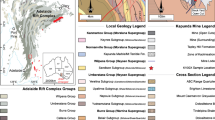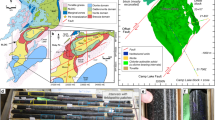Summary
The mineralized stock of the Hobenzan granitic complex is composed of tonalite and a continuous differentiation series of biotite-hornblende granodiorite, hornblende biotite granite and biotite granite. Texture and mineral chemistry of the Fe-Ti oxide minerals in the Hobenzan granitic complex exhibit two different processes of magma evolution: one is an oxyexsolution process related to the magmatic and high temperature subsolidus stage, and the other is a reduction process of consecutive subsolidus stage. Rocks distributed in the northern part of the granitic complex preserve well the oxyexsolution process and show higher magnetic susceptibility, whereas those in the southern part of the complex, record the reduction process and show lower magnetic susceptibility.
The magnetite-ilmenite geothermometer indicates temperatures of ca. 730°C for the oxide pairs of the early stage. Oxygen fugacity of one to three orders of magnitude higher than the annite-sanidine-magnetite (ASM) univariant curve, and an aqueous sulfur composition,fSO2/fH2S, of around 1.0 is indicated. This first stage corresponds to the crystallization of phenocrystic hornblende and plagioclase at depth. At about 700°C crystallization changed to biotite, K-feldspar and quartz, and continued to about 600°C. ThefO2 during this second stage is buffered by the ASM assemblage. This second stage defines the oxyexsolution process. Below about 600°C, a reduction process, caused by assimilation of carbonaceous matter of country rocks, overprinted the southern part of the complex. Oxide pairs show that thefO2 is about four orders of magnitude lower than the ASM univariant curve, andfSO2/fH2S is 10−8.0 or less at 550°C for this reduced assemblage. The drastic change in composition of sulfur-bearing aqueous species may be one of the principal factors allowing base metal mineralization.
Zusammenfassung
Der mineralisierte Hobenzan Granitkomplex setzt sich aus Tonaliten und einer kontinuierlichen Differentiationsserie, bestehend aus Biotit-Hornblende-Granodioriten, Hornblende-Biotit-Graniten und Biotit-Graniten, zusammen. Die Texturen und die Mineralchemie der Fe-Ti Oxide belegen zwei unterschiedliche Prozesse bei der Entwicklung des Hobenzan Granitkomplexes: einerseits einen Oxyexsolution-Prozeß, während des magmatischen und hochtemperierten Subsolidus-Stadiums, andererseits einen Reduktionsprozeß während des tiefertemperierten Subsolidus-Stadiums. Gesteine im nördlichen Hobenzan Komplex belegen vor allem den Oxyexsolution Prozeß und zeigen höhere magnetische Suszeptibilität, während jene im südlichen Teil den Reduktionsprozeß widerspiegeln und niedrigere magnetische Suszeptibilität zeigen.
Das Magnetit-Ilmenit Geothermometer ergab Temperaturen von ca. 730°C für Oxidpaare des Frühstadiums. Die Sauerstoff Fugazität liegt um eine bis drei Größenordnungen über der univarianten Reaktionskurve Annit-Sanidin-Magnetit (ASM), und dasfSO2/fH2S Verhältnis der wässrigen Schwefelkomplexe bei ca. 1.0. Dieses Frühstadium korrespondiert mit der Kristallisation von Horblende und Plagioklas im Magma in größerer Tiefe. Ab ca. 700°C erfolgt die Kristallisation von Biotit, Alkalifeldspat und Quarz bis etwa 600°C, wobeifO2 durch die ASM Mineralassoziation gepuffert wird. Dieses zweite Stadium wird als Oxyexsolution Prozeß beschrieben. Unter 600°C erfolgte eine Reduktion durch Assimilation von kohlenstoffreichem Material vor allem im südlichen Teil des Komplexes. Oxidpaare dieses Stadiums belegen, daßfO2 um etwa vier Größenordnungen unterhalb des ASM Puffers liegt, undfSO2/fH2S ist ⩽ 10−8 bei 550°C. Die dramatische Änderung in der Zusammensetzung der Schwefelkomplexe in den Lösungen wird als der Hauptfaktor für die Bildung der Erzmineralisationen angesehen.
Similar content being viewed by others
References
Anderson AT (1968) Oxidation of the LaBlache Lake titaniferous deposit, Quebec. J Geol 76: 528–547
Anderson JL (1980) Mineral equilibria and crystallization condition in the late Precambrian Wolf River rapakivi massif, Wisconsin. Am J Sci 280: 298–332
Barnes HL (1979) Solubility of ore minerals. In:Barnes HL(ed) Geochemistry of hydrothermal ore deposits, 2nd ed. John Wiley and Sons, New York, pp 404–460
Buddington AF, Lindsley DH (1964) Iron-titanium oxide minerals and synthetic equivalents. J Petrol 5: 310–357
Burnham CW (1979) Magmas and hydrothermal fluids. In:Barnes HL(ed) Geochemistry of hydrothermal ore deposits, 2nd ed. John Wiley and Sons, New York, pp 71–136
Burnham CW, Ohmoto H (1980) Late-stage processes of felsic magmatism. Mining Geol [Spec Issue] 8: 1–12
Burnham CW, Holloway JR, Davis NF (1969) Thermodynamic properties of water to 1,000°C and 10,000 bars. Geol Soc Am [Spec paper] No 132, 96 pp
Carmichael ISE (1967) The iron-titanium oxide of salic volcanic rocks and their associated ferro-magnesian silicates. Contrib Mineral Petrol 14: 36–64
Czamanske GK, Ishihara S, Atkin SA (1981) Chemistry of rock-forming minerals of the Cretaceous-Paleogene batholith in southwestern Japan and implications for magma genesis. J Geophys Res 86: 10431–10469
Eugster HP (1957) Heterogeneous reactions involving oxidation and reduction at high pressures and temperatures. J Chem Phys 26: 1760–1761
Frost BR (1985) On the stability of sulfides, oxides and native metals in serpentinite. J Petrol 26: 31–63
Frost BR, Lindsley DH (1991) Occurrence of iron-titanium oxides in igneous rocks. In:Lindsley H (ed) Reviews in mineralogy 25. Mineral Soc Am, pp 433–468
Fujii A (1972) Ota Formation of the Yamaguchi Group in the Akiyoshi district. J Geol Soc Jpn 78: 309–321 (in Japanese with English abstract)
Fujimaki H, Aoki K (1980) Quantitative microanalyses of silicates, oxides and sulfides using an energy-dispersive type electron probe. Sci Rept Tohoku Univ, Ser 111, 14: 261–268
Ghiorso MS, Sack RO (1991) Fe-Ti oxide geothermometry: thermodynamic formulation and the estimation of intensive variables in silicic magmas. Contrib Mineral Petrol 108: 485–510
Haggerty SE (1976) Opaque mineral oxides in terrestrial igneous rocks. In:Rumble D (ed) Oxide minerals. Mineral Soc Am, Short Course Notes, Hg 101-300. Southern Printing Co, Blacksburg
Imaoka T, Nakashima K, Murakami N (1982) Iron-titanium oxide minerals of Cretaceous to Paleogene volcanic rocks in western Chugoku district, southwest Japan. J Jpn Assoc Min Petr Econ Geol 77: 235–255
Imaoka T, Nakashima K, Murakami N, Matsuda T (1985) Fe-Ti oxide minerals from plutonic rocks associated with Paleogene cauldrons in West San-in district, Japan. J Fac Lib Arts, Yamaguchi Univ 19: 20–31 (in Japanese with English abstract)
Ishihara S (1977) The magnetite-series and ilmenite-series granitic rocks. Mining Geol 27: 293–305
Ishihara S (1981) Granitoid series and mineralization. Econ Geol (75th Anniv Vol): 414–484
Ishihara S, Sato K, Terashima S (1984) Chemical characteristics and genesis of mineralized, intermediate-series granitic pluton in the Hobenzan area, western Japan. Mining Geol 34: 401–418
Kawano Y, Ueda Y (1966) K-A dating on the igneous rocks in Japan, V. Granitic rocks in southwest Japan. J Jpn Assoc Min Petr Econ Geol 56: 191–211 (in Japanese with English abstract)
Mariko T, Tanaka K, Itaya T (1975) Oxide and sulfide minerals in pelitic and psammitic schists from the Nagatoro district, Saitama Prefecture, Japan. J Jpn Assoc Min Petr Econ Geol 70: 413–424
Murata M, Itaya T, Ueda Y (1983) Sulfide and oxide minerals from the Ohmine granitic rocks in Kii Peninsula, Central Japan, and their primary paragenetic relations. Contrib Mineral Petrol 84: 58–65
Nakashima K (1988) Acid magmatism and related mineralization - a case study. Hobenzan granitic complex, Yamaguchi Prefecture, southwest Japan, 1. Petrochemistry. Bull Yamagata Univ (Natural Science) 12(1): 63–86
Nakashima K, Watanabe M, Soeda A (1981) Mineralogy of the Cu-Bi-W-Co-As-S mineralization associated with the Hobenzan granitic complex, Yamaguchi Prefecture, southwest Japan. J Jpn Assoc Min Petr Econ Geol 76: 1–16
Nakashima K, Imaoka T, Murakami N (1984) Petrography, bulk chemical composition and magnetic susceptibility of the Hobenzan granitic complex, Yamaguchi Prefecture, southwest Japan. J Jpn Assoc Min Petr Econ Geol 79: 370–386 (in Japanese with English abstract)
Ohmoto H, Kerrick D (1977) Devolatilization equilibria in graphitic systems. Am J Sci 277: 1013–1044
Rose AW, Burt DM (1979) Hydrothermal alteration. In:Barnes HL (ed) Geochemistry of hydrothermal ore deposits, 2nd ed. John Wiley and Sons, New York, pp 173–235
Shibata K, Ishihara S (1979) Rb-Sr whole-rock and K-Ar mineral ages of granitic rocks in Japan. Geochem J 13: 113–119
Shibata K, Nishimura Y (1989) Isotopic ages of the Sangun crystalline schists, southwest Japan. Mem Geol Soc Japan 33: 317–341 (in Japanese with English abstract)
Spencer KJ, Lindsley DH (1981) A solution model for coexisting iron-titanium oxides. Am Mineral 66: 1189–1201
Streckeisen AL (1973) Plutonic rocks, classification and nomenclature recommended by the IUGS subcommission on the systematics of igneous rocks. Geotimes 18: 25–30
Tainosho Y (1982) Fe-Ti oxide minerals of the late Mesozoic to early Tertiary granitic rocks in eastern Chugoku and Kinki districts, southwest Japan. J Jpn Assoc Min Petr Econ Geol 77: 387–402 (in Japanese with English abstract)
Tainosho Y, Houma H, Tazaki K (1979) Mineral chemistry of granitic rocks in eastern Chugoku, southwest Japan. Mem Geol Soc Japan 17: 99–112 (in Japanese with English abstract)
Tsusue A, Ishihara S (1974) The iron-titanium oxides in the granitic rocks of southwest Japan. Mining Geol 24: 13–30 (in Japanese with English abstract)
Waldbaum DR, Thompson JB (1969) Mixing properties of sanidine crystalline solutions, IV. Phase diagrams from equations of state. Am Mineral 54: 1274–1298
Wones DR (1981) Mafic silicates as indicators of intensive variables in granitic magmas. Mining Geol 31: 191–212
Author information
Authors and Affiliations
Additional information
With 5 Figures
Rights and permissions
About this article
Cite this article
Nakashima, K. Chemistry of Fe-Ti oxide minerals in the Hobenzan granitic complex, SW Japan: Subsolidus reduction in relation to base metal mineralization. Mineralogy and Petrology 58, 51–69 (1996). https://doi.org/10.1007/BF01165763
Received:
Accepted:
Issue Date:
DOI: https://doi.org/10.1007/BF01165763




